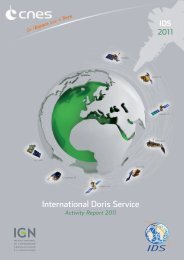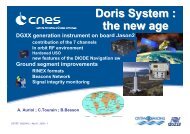The International DORIS Service July 2003 – December 2005 report
The International DORIS Service July 2003 – December 2005 report
The International DORIS Service July 2003 – December 2005 report
Create successful ePaper yourself
Turn your PDF publications into a flip-book with our unique Google optimized e-Paper software.
IDS Report <strong>–</strong> <strong>July</strong> <strong>2003</strong> to <strong>December</strong> <strong>2005</strong> 21<br />
6 THE SATELLITES FITTED OUT WITH <strong>DORIS</strong> RECEIVERS<br />
Gilles Tavernier (1)<br />
(1) CNES, France<br />
Initially conceived in the context of the TOPEX/Poseidon mission, the first generation receivers<br />
were flown on four satellites:<br />
- SPOT-2, a CNES remote sensing satellite was launched in 1990, with the first <strong>DORIS</strong><br />
receiver for a 6-month probationary experiment. More than 16 years after the launch, this<br />
receiver is still fully operational,<br />
- TOPEX/Poseidon, a joint venture between CNES and NASA to map ocean surface<br />
topography was launched in 1992. While a 3-year prime mission was planned, with a 5-<br />
year store of expendables, TOPEX/Poseidon has delivered an astonishing 13+ years of<br />
data from orbit: the <strong>DORIS</strong> mission ended with the second receiver failure in November<br />
2004 whereas the ocean surface topography mapping ended in October <strong>2005</strong>,<br />
- SPOT-3 (CNES) was launched in 1993; the spacecraft was lost in November 1996,<br />
- SPOT-4 (CNES) was launched in 1998, featuring the first <strong>DORIS</strong> real time on-board orbit<br />
determination (DIODE).<br />
In the mid-nineties, CNES developed a second generation dual channel <strong>DORIS</strong> receiver which<br />
was miniaturized in the late nineties:<br />
- Jason-1, the CNES/NASA TOPEX follow-on mission was launched on <strong>December</strong> 7, 2001<br />
with a miniaturized second generation <strong>DORIS</strong> receiver. <strong>The</strong> receiver was switched on<br />
<strong>December</strong> 8 and automatically started. <strong>The</strong> orbit accuracy is getting close to one<br />
centimeter on the radial component (Luthcke et al. <strong>2003</strong>; Haines et al. 2004). At the<br />
present time, Jason-1 <strong>DORIS</strong> measurements are not used for geodesy, owing to the<br />
South Atlantic Anomaly (SAA) effect on the on-board Ultra Stable Oscillators (USO)<br />
(Willis et al. 2004), however a correction model has recently been developed (Lemoine<br />
and Capdeville submitted),<br />
- Envisat, the ESA mission to ensure the continuity of the data measurements of the ESA<br />
ERS satellites was launched on March 1, 2002 with a second generation <strong>DORIS</strong><br />
receiver,<br />
- SPOT-5 (CNES) was launched on May 4, 2002 with a miniaturized second generation<br />
<strong>DORIS</strong> receiver.<br />
Figure 9 gives a summary of the satellites providing <strong>DORIS</strong> data to the IDS data centers, as<br />
well as the evolution in time of the number of these satellites. Some of the early SPOT-2 data






